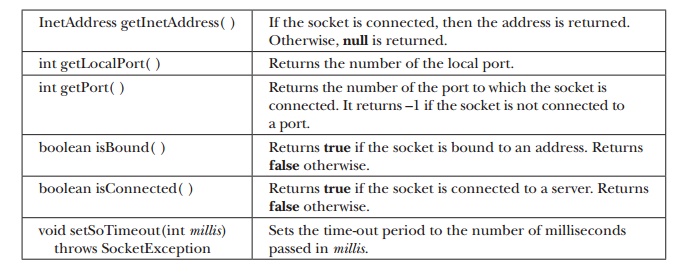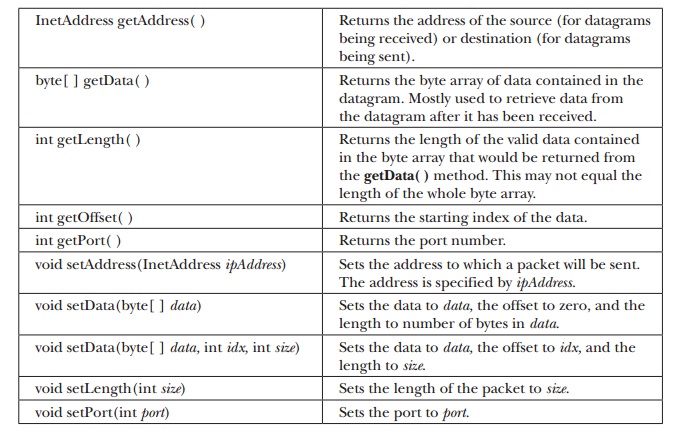Chapter: Java The Complete Reference : The Java Library : Networking
Datagrams - Java Networking
Datagrams
TCP/IP-style
networking is appropriate for most networking needs. It provides a serialized,
predictable, reliable stream of packet data. This is not without its cost,
however. TCP includes many complicated algorithms for dealing with congestion
control on crowded networks, as well as pessimistic expectations about packet
loss. This leads to a somewhat inefficient way to transport data. Datagrams
provide an alternative.
Datagrams are bundles of information passed between
machines. They are somewhat like a
hard throw from a well-trained but blindfolded catcher to the third baseman.
Once the datagram has been released to its intended target, there is no
assurance that it will arrive or even that someone will be there to catch it.
Likewise, when the datagram is received, there is no assurance that it hasn’t
been damaged in transit or that whoever sent it is still there to receive a
response.
Java
implements datagrams on top of the UDP protocol by using two classes: the DatagramPacket object is the data
container, while the DatagramSocket is
the mechanism used to send or
receive the DatagramPackets. Each is
examined here.
DatagramSocket
DatagramSocket defines four public
constructors. They are shown here: DatagramSocket(
) throws SocketException
DatagramSocket(int
port) throws SocketException
DatagramSocket(int
port, InetAddress ipAddress) throws SocketException
DatagramSocket(SocketAddress address)
throws SocketException
The
first creates a DatagramSocket bound
to any unused port on the local computer. The second creates a DatagramSocket bound to the port
specified by port. The third
constructs a DatagramSocket bound to
the specified port and InetAddress.
The fourth constructs a
DatagramSocket bound to the specified SocketAddress. SocketAddress is an abstract class that is implemented by the
concrete class InetSocketAddress. InetSocketAddress encapsulates an IP
address with a port number. All can throw a SocketException if an error occurs while creating the socket.
DatagramSocket defines many methods. Two of
the most important are send( ) and receive( ), which are shown here:
void
send(DatagramPacket packet) throws
IOException void receive(DatagramPacket packet)
throws IOException
The send( ) method sends a packet to the
port specified by packet. The receive( ) method waits for a packet to
be received and returns the result.
DatagramSocket also defines the close( )method, which closes the
socket. Beginning with JDK 7, DatagramSocket implements AutoCloseable, which means that a DatagramSocket can be managed by a try-with-resources block.
Other
methods give you access to various attributes associated with a DatagramSocket. Here is a sampling:

InetAddress getInetAddress( )
: If the socket is connected, then the address is returned. Otherwise, null is
returned.
int getLocalPort( ) : Returns
the number of the local port.
int getPort( ) : Returns the
number of the port to which the socket is connected. It returns –1 if the
socket is not connected to a port.
boolean isBound( ) : Returns
true if the socket is bound to an address. Returns false otherwise.
boolean isConnected( ) :
Returns true if the socket is connected to a server. Returns false otherwise.
void setSoTimeout(int millis)
throws SocketException : Sets the time-out period to the number of milliseconds
passed in millis.
DatagramPacket
DatagramPacket defines several constructors.
Four are shown here:
DatagramPacket(byte
data [ ], int size) DatagramPacket(byte data
[ ], int offset, int size)
DatagramPacket(byte
data [ ], int size, InetAddress ipAddress,
int port) DatagramPacket(byte data [ ], int offset, int size,
InetAddress ipAddress, int port)
The
first constructor specifies a buffer that will receive data and the size of a
packet. It is used for receiving data over a DatagramSocket. The second form allows you to specify an offset
into the buffer at which data will be stored. The third form specifies a target
address and port, which are used by a DatagramSocket
to determine where the data in the packet will be sent. The fourth form
transmits packets beginning at the specified offset into the data. Think of the
first two forms as building an "in box," and the second two forms as
stuffing and addressing an envelope.
DatagramPacket defines several methods,
including those shown here, that give access to the address and port number of a packet, as well as the raw
data and its length.

InetAddress getAddress( ) :
Returns the address of the source (for datagrams being received) or destination
(for datagrams being sent).
byte[ ] getData( ) : Returns
the byte array of data contained in the datagram. Mostly used to retrieve data
from the datagram after it has been received.
int getLength( ) : Returns
the length of the valid data contained in the byte array that would be returned
from the getData( ) method. This may not equal the length of the whole byte
array.
int getOffset( ) : Returns
the starting index of the data.
int getPort( ) : Returns the
port number.
void setAddress(InetAddress
ipAddress) : Sets the address to which a packet will be sent. The address is
specified by ipAddress.
void setData(byte[ ] data) :
Sets the data to data, the offset to zero, and the length to number of bytes in
data.
void setData(byte[ ] data,
int idx, int size) : Sets the data to data, the offset to idx, and the length
to size.
void setLength(int size) :
Sets the length of the packet to size.
void setPort(int port) : Sets
the port to port.
A Datagram Example
The
following example implements a very simple networked communications client and
server. Messages are typed into the window at the server and written across the
network to the client side, where they are displayed.
// Demonstrate datagrams.
import java.net.*;
class WriteServer {
public static int serverPort
= 998; public static int clientPort = 999; public static int buffer_size =
1024; public static DatagramSocket ds;
public static byte buffer[] =
new byte[buffer_size];
public static void
TheServer() throws Exception { int pos=0;
while (true) {
int c = System.in.read();
switch (c) {
case -1:
System.out.println("Server
Quits.");
ds.close();
return; case '\r': break;
case '\n':
ds.send(new
DatagramPacket(buffer,pos, InetAddress.getLocalHost(),clientPort));
pos=0;
break;
default:
buffer[pos++] = (byte) c;
}
}
}
public static void
TheClient() throws Exception { while(true) {
DatagramPacket p = new
DatagramPacket(buffer, buffer.length); ds.receive(p);
System.out.println(new
String(p.getData(), 0, p.getLength()));
}
}
public static void
main(String args[]) throws Exception { if(args.length == 1) {
ds = new
DatagramSocket(serverPort); TheServer();
} else {
ds = new
DatagramSocket(clientPort); TheClient();
}
}
}
This
sample program is restricted by the DatagramSocket
constructor to running between two ports on the local machine. To use the
program, run
java WriteServer
in one
window; this will be the client. Then run
java WriteServer 1
This will
be the server. Anything that is typed in the server window will be sent to the
client window after a newline is received.
Related Topics